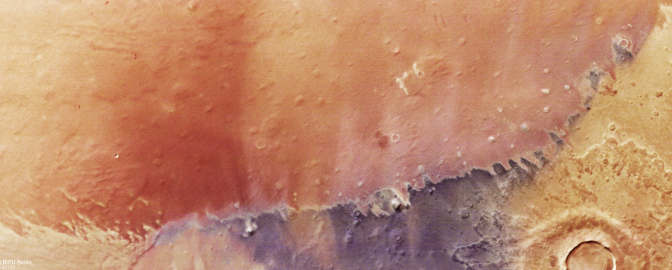Extraterrestrial lights
How other worlds experience auroras

Written by
Asa Stahl, PhD
Science Editor, The Planetary Society
June 9, 2025
We’re not the only world with dazzling auroras. Moons, planets, and even comets can have their own light shows, and some are very different from what we have on Earth. Auroras can be big or small, faint or bright, sputtering, steady, and virtually every color of the rainbow. These swirls and arcs often reveal hidden aspects of other worlds, and sometimes, they pose mysteries of their own.
Most auroras in the Solar System are powered by the solar wind: a torrent of charged particles constantly unleashed by our Sun. On Earth, the aurora borealis (northern lights) and aurora australis (southern lights) both get triggered when the solar wind dumps energy into our magnetic field, causing ions to rain down over the north and south poles. When this shower hits our atmosphere, it excites gases like oxygen and nitrogen into giving off an ethereal glow.
But not every aurora works the same way. Though all auroras are powered by charged particles running into something, some don’t rely on the solar wind. Others don’t depend on thick atmospheres, and a few don’t even need strong magnetic fields.
Take Venus. Scientists have seen faint green and blue auroras from our neighboring world, but it has no global magnetic field. Instead, Venus has local magnetic fields that form when the solar wind interacts with ions in the planet’s atmosphere. These fields are weak and patchy, but they’re still able to capture other solar wind particles and make the sky glow.
Mars takes this one step further: It has no global magnetic field and only a thin atmosphere, but it boasts at least four different kinds of auroras. One appears on the sunlit side of the planet, another extends like ribbons across its skies, and a third is caused by the solar wind getting trapped by weak magnetic fields in the Martian crust. The fourth kind of aurora, which sometimes spreads over the entire planet, was spotted by the Perseverance rover in 2024. This marked the first time an aurora has ever been observed from the surface of another world.
Compared to Jupiter, though, these spectacles are like candles in the wind. Auroras on Jupiter are the most powerful in the Solar System and up to 1,000 times brighter than those on Earth. Though they mostly shine in the ultraviolet and infrared, someone standing atop Jupiter’s cloud deck might be able to spot faint colors in its night sky. The glows would look red and possibly also purple and blue because of the hydrogen in the planet’s atmosphere.

Unlike Earth, Jupiter’s auroras can shine without the solar wind. The bulk of their brightness comes from the fact that while Jupiter rotates — at a breakneck speed of over 43,000 kilometers per hour (28,000 miles per hour) at some altitudes — its strong magnetic field whips up debris ejected from volcanoes on its moon Io. This channels electrons down toward the planet’s poles, where they trigger ring-shaped auroras. Sometimes, these rings are also joined by bright spots, each one powered by a magnetic connection between Jupiter and one of its moons.
Some of these moons have their own auroras too. On the volcanic moon Io, auroras could even appear as a full-color rainbow. Astronomers expect this world’s skies to glow red from sulfur and oxygen, orange-yellow from sodium, green from oxygen, and blue from sulfur dioxide.
The moons Europa and Ganymede have auroras that are spectacular in a different way: Each provides a strong sign of a vast, hidden ocean. The trick is that auroras, like the charged particles that make them, follow patterns in magnetic fields. As Jupiter’s magnetic field changes, it gives rise to electric currents in the water of these buried oceans, and those currents then generate their own magnetic fields. By watching the auroras on Ganymede and Europa, scientists concluded both moons are very likely to have subsurface oceans — in Europa’s case, a potentially habitable ocean.
Saturn’s auroras are a lot like those on Jupiter. It has glowing rings wrapped around its poles, plus occasional spots and arcs from connections with its moons. To the naked eye, these auroras might look like a pink glow with purple streaks.

Auroras on Uranus and Neptune may be the most mysterious in the Solar System. Since the magnetic fields of these ice giants are tilted and off-center, they tend to interact with the solar wind in odd ways, making for sporadic auroras in a variety of places on both planets. But Uranus and Neptune are also far enough away from the Sun that the solar wind tends to affect them less. This makes their auroras weak and, for the most part, unexplored.

Then there are the oddballs. For instance, worlds that are not quite massive enough to become stars, called “brown dwarfs,” could also have auroras. Since brown dwarfs tend to have strong magnetic fields and rotate quickly, all they would need is a source of charged particles, like a volcanic planet, to produce auroras even brighter than Jupiter’s.
It gets weirder. Using data from the European Space Agency’s Rosetta spacecraft, scientists have found auroralike radiation coming from the comet 67P/Churyumov-Gerasimenko. Though the comet has no significant magnetic field, solar wind particles still collide with it and trigger ultraviolet and X-ray glows.
Or take Mercury, a planet whose atmosphere is too thin to have conventional auroras. The solar wind often makes particles rain down on Mercury’s surface, exciting molecules on the ground to emit light. The process isn’t so different from how the solar wind causes showers of charged particles on Earth, but instead of hitting a planet’s atmosphere, the particles smack straight into its surface. Does that still technically count as auroras?
Questions like this continue to surprise scientists. The glows on Mercury were only confirmed by the joint European-Japanese BepiColombo mission in 2023, while comet auroras first made the news in 2020. There might still be other undiscovered auroras out there, waiting to tell us more about their worlds. And since these lights get more intense at solar maximum, when the solar wind is strongest, now is the time when our clues are shining brightest.
Support our core enterprises
Your gift today will go far to help us close out the year strong and keep up our momentum in 2026.
DonateThe Planetary Report • June Solstice
Help advance space science and exploration! Become a member of The Planetary Society and you'll receive the full PDF and print versions of The Planetary Report.


 Explore Worlds
Explore Worlds Find Life
Find Life Defend Earth
Defend Earth


